Best Gardening Tools for Beginners: 2024 Essential
- March 28, 2024
- 0 comment
Explore essential best gardening tools for beginners in this guide, designed to simplify starting your garden and making the experience rewarding. However, starting a garden can feel overwhelming for beginners, especially when it comes to selecting the right tools. Fear not, budding gardeners! This guide will introduce you to essential gardening tools that are perfect for beginners.
Yard work made easy! We’ve got reviews on the best lawn sprinklers, best lawn mowers, best zero-turn mowers, best lawn aerators, and STIHL’s best trimmers – all to keep your lawn looking lush!
List of Best Gardening Tools
- Hand Trowel
- Garden Gloves
- Pruning Shears
- Watering Can
- Garden Fork
- Spade
- Rake
- Hoe
- Water Hose with Adjustable Nozzle
- Wheelbarrow
Top Gardening Tools for Beginners
1. Hand Trowel
A hand trowel is a small, shovel-like tool essential for numerous gardening tasks. Whether you’re planting herbs, digging small holes, or transferring plants to pots, a sturdy hand trowel is your go-to tool. Look for one with a comfortable handle and a durable, rust-resistant blade.
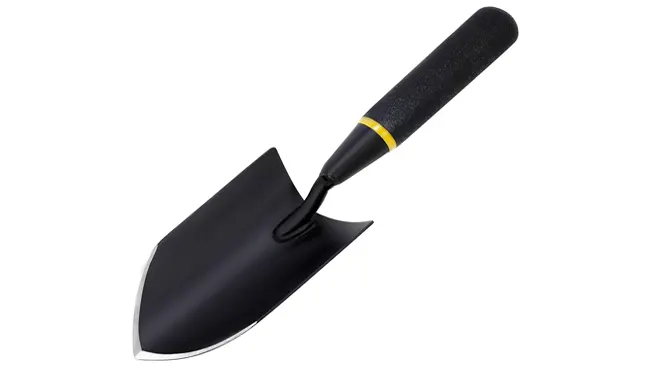
Uses and Benefits
- Planting and Transplanting: Hand trowels are perfect for digging small holes for planting seeds, bulbs, or transplanting small plants and seedlings.
- Weeding: Their pointed tip and sharp edge make them effective for uprooting weeds, especially around delicate plants.
- Mixing Soil and Adding Fertilizers: They are useful for mixing in fertilizers or compost into the soil around plants.
- Potting: Hand trowels are ideal for potting and repotting plants, allowing for precise control in small containers.
- Aerating Soil: They can be used to gently aerate the soil around plants, which helps with water and nutrient absorption.
2. Garden Gloves
Protecting your hands is crucial in gardening. Quality garden gloves prevent blisters, shield your skin from thorns, and keep your hands clean. Opt for gloves that are durable yet flexible to allow for easy movement.
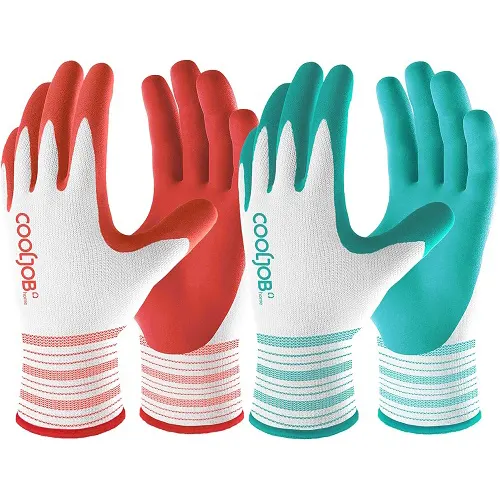
Uses and Benefits
- Handling Rough Material: Gloves are useful when handling rough materials like wood chips, rocks, or heavy tools.
- Weeding and Pruning: They provide protection when pulling weeds or pruning plants, which often involve sharp edges or thorns.
- Transplanting and Potting: Gloves keep your hands clean when handling soil, compost, and potting mixtures.
- Pest and Disease Protection: They offer a barrier against pests and plant diseases that can be harmful to touch.
- Water Resistance: Some gloves are water-resistant, which is beneficial when working in wet soil or during watering.
- Specialized Types: There are specialized gloves for different tasks, like waterproof gloves for watering or heavier gloves for pruning.
3. Pruning Shears
Pruning shears, or secateurs, are used for trimming and shaping plants and bushes. They are vital for encouraging healthy plant growth. Beginners should choose bypass pruning shears for their ease of use and clean cuts.
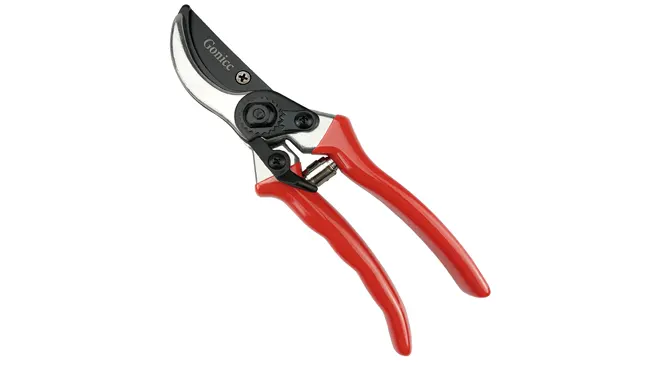
Uses and Benefits
- Trimming and Shaping Plants: Ideal for shaping plants to a desired form.
- Removing Dead or Damaged Branches: Helps in cutting away dead or diseased branches, which is essential for the plant’s health.
- Harvesting: Can be used for harvesting fruits and flowers.
- Encouraging Flowering and Fruiting: By pruning, plants can direct more energy towards flowering and fruiting.
- Creating Aesthetically Pleasing Gardens: Helps in maintaining a neat and tidy appearance of garden plants.
- Promoting Air Circulation and Sunlight Penetration: Removing excess growth can improve air circulation and light penetration, benefiting the overall plant health.
4. Watering Can
A watering can with a long spout provides precision and control, making it ideal for watering potted plants and seedlings. It’s an indispensable tool for gardeners, especially those starting with a small garden or balcony space.
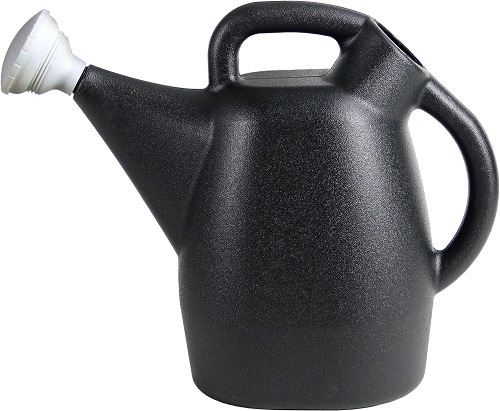
Uses and Benefits
- Targeted Watering: Ideal for targeting specific plants or areas in the garden, especially useful for newly planted seeds or seedlings that need careful watering.
- Control Over Water Amount: Helps in controlling the amount of water used, reducing wastage, and ensuring that plants are not over-watered.
- Versatility: Can be used for both indoor and outdoor plants.
- Doubles as a Fertilizer Distributor: Can be used to apply liquid fertilizer evenly over the soil.
- Accessibility: Perfect for hard-to-reach plants, as the long spout can extend over obstacles and into tight spaces.
- Aesthetic Appeal: Many watering cans have an appealing design, making them decorative as well as functional.
5. Garden Fork
A garden fork is an invaluable tool for breaking up soil, especially in areas that are too tough for a spade. It’s also great for mixing in compost or manure. Beginners should choose a fork with sturdy, sharp tines and a comfortable handle.
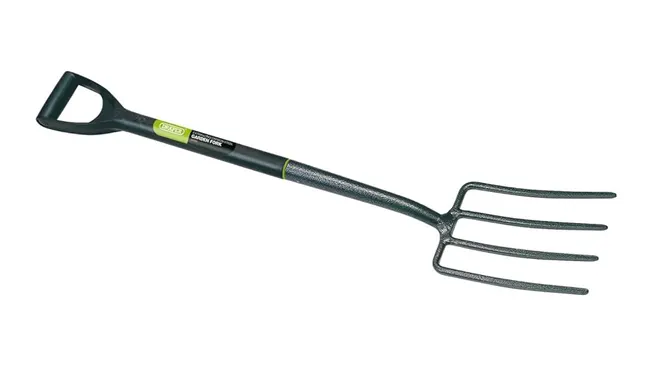
Uses and Benefits
- Breaking Up Soil: Ideal for loosening and turning over soil, preparing it for planting or improving its structure.
- Improving Soil Fertility: By integrating compost or manure into the soil, it increases nutrient levels, benefiting plant growth.
- Harvesting Root Crops: Garden forks can be used to gently lift root vegetables like potatoes and carrots from the ground.
- Weeding: Helps in removing weeds with deep roots, as the tines can get underneath the roots for easier extraction.
- Aerating Compost Piles: Useful in turning compost piles to speed up the decomposition process and improve compost quality.
6. Spade
A spade, essential for gardeners, is a versatile tool with a square blade ideal for digging, edging, and moving soil. Its strong handle and comfortable grip make it perfect for tasks like lifting sod and creating clean edges in garden beds. Investing in a high-quality spade enhances gardening efficiency and ease.
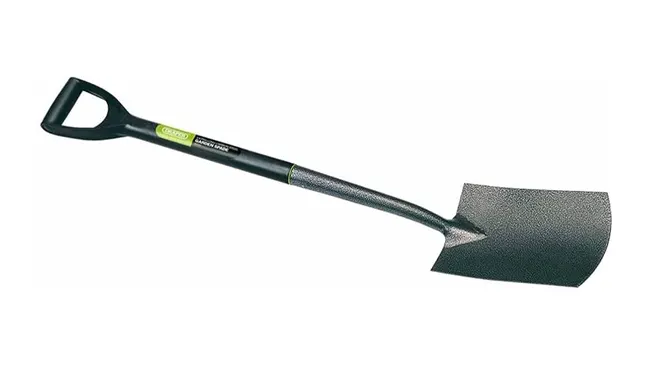
Uses and Benefits
- Digging and Transplanting: Spades are excellent for digging holes for plants and transplanting small shrubs or perennials.
- Edging Garden Beds: The flat, sharp blade is ideal for creating clean edges around garden beds or walkways.
- Lifting Sod: It’s useful for cutting and lifting sod or turf, either to lay new lawn or to clear an area for planting.
- Turning Soil: A spade can be used for turning over and aerating soil, an important task for maintaining soil health.
- Incorporating Amendments: It’s effective for mixing in compost, manure, or other soil amendments to enrich garden beds.
- Compact Soil Work: Its size makes it suitable for working in confined spaces like raised beds or densely planted areas.
7. Rake
A garden rake is essential for beginners as it efficiently clears leaves, debris, and prepares soil for planting. Its metal head and robust handle ensure durability and ease of use. This tool is fundamental for maintaining a tidy and healthy garden environment.
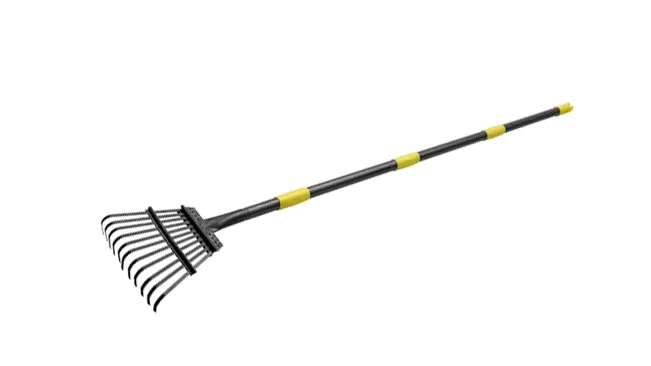
Uses and Benefits
- Clearing Leaves and Debris: A garden rake is highly effective in gathering leaves, grass clippings, and other garden debris, keeping your garden tidy.
- Soil Preparation: It can be used to break up clumps of soil and smooth out the surface, preparing the ground for planting.
- Weed Control: Rakes can help in removing small weeds and keeping the soil aerated, promoting healthier plant growth.
- Leveling Ground: A rake is handy for leveling soil or compost when setting up a planting bed or a lawn area.
- Spreading Mulch: It allows for even distribution of mulch around plants, which can help with moisture retention and weed suppression.
- Detaching Lawn: For lawn care, rakes can be used to remove thatch (a layer of dead grass) to promote healthier lawn growth.
8. Hoe
A garden hoe is an indispensable tool for beginners, ideal for weeding and soil cultivation in a garden. It comes in various forms, with the Dutch or draw hoe being particularly user-friendly for novices. This tool not only simplifies garden maintenance but also aids in promoting healthy plant growth.
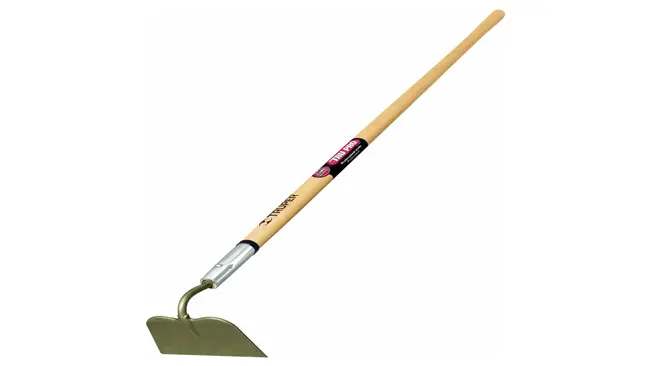
Uses and Benefits
- Weeding: A garden hoe is highly effective for removing weeds. By slicing through the soil, it can cut weeds at the roots, preventing them from regrowing.
- Soil Cultivation: Hoes are great for breaking up soil clumps, allowing for better air and water penetration. This promotes healthier plant growth.
- Aerating Soil: Regular use of a hoe can help aerate the soil, which is essential for root growth and nutrient absorption.
- Creating Planting Rows: For vegetable gardens, a hoe can be used to create neat rows and trenches for planting seeds.
- Versatility: Different hoe designs are suitable for various tasks, from light surface weeding to deeper cultivation.
9. Water Hose with Adjustable Nozzle
A water hose with an adjustable nozzle is ideal for larger gardens, offering efficiency and ease of use. The adjustable nozzle enables precise control over the water flow and spray pattern. This feature simplifies the task of effectively watering different types of plants.
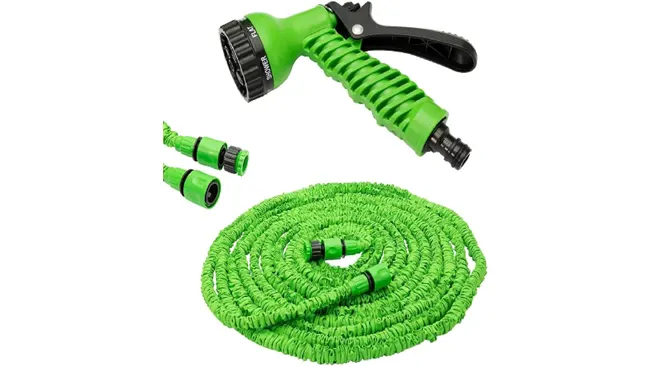
Uses and Benefits
- Diverse Gardening Tasks: Ideal for everything from watering plants and lawns to washing off garden tools and outdoor furniture.
- Adjustable Settings: Benefit from settings that range from a fine mist for seedlings to a strong jet for cleaning.
- Reach: Allows you to water hard-to-reach areas without having to carry a watering can back and forth.
- Time-Saving: Quickly and efficiently water large areas.
- Comfort: Easier on the hands and back, especially beneficial for those who find it hard to carry heavy loads or stand for long periods.
10. Wheelbarrow
A wheelbarrow is an essential tool for large gardens, offering an efficient way to transport heavy materials like soil, compost, and garden tools. Opting for a lightweight model enhances ease of maneuverability, making gardening tasks less physically demanding. However, be mindful of the space needed for storage and the physical effort required, especially on uneven terrain.
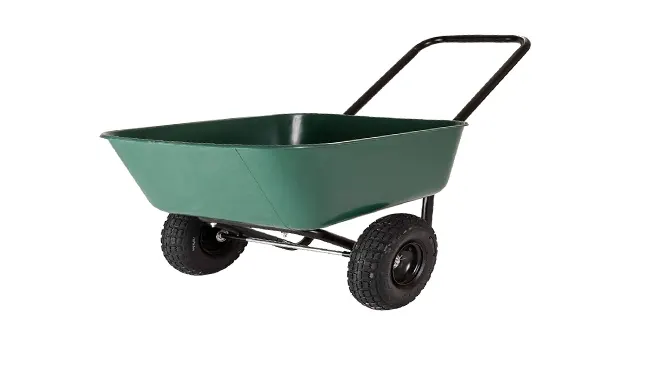
Uses and Benefits
- Transporting Soil and Compost: Easily move large amounts of soil, compost, or mulch to different parts of the garden.
- Carrying Plants and Garden Equipment: Transport plants, pots, and garden tools from one location to another efficiently.
- Mixing Soil or Fertilizer: You can use a wheelbarrow to mix soil, compost, or fertilizers before applying them to your garden.
- Weed and Debris Removal: Collect and transport weeds, leaves, and garden debris for disposal or composting.
- Versatile Utility: Apart from gardening, wheelbarrows are useful in various other outdoor tasks, like carrying firewood or assisting in small construction projects.
- Health and Exercise: Physically engaging with a wheelbarrow can offer a moderate workout, particularly beneficial for those looking to stay active.
Gardening Tool Care Tips
Maintaining your gardening tools is essential for ensuring their longevity and effectiveness. Proper care prevents rust, wear, and ensures that your tools remain sharp and efficient. Here are some indispensable care tips:
- Clean Regularly: After each use, remove soil and debris from your tools. A stiff brush and water are usually sufficient for cleaning. For stubborn dirt, consider using a mild detergent.
- Dry Thoroughly: Moisture is the main culprit for rust. Dry your tools thoroughly after washing. Store them in a dry place, away from the elements.
- Sharpening: Keep cutting tools like shears and pruners sharp. A dull tool can damage your plants and make gardening tasks more laborious. Use a sharpening stone or file to maintain a sharp edge.
- Oil Metal Parts: To prevent rust and ensure smooth operation, lightly oil metal components, especially before storing tools for the winter. Use a cloth dampened with machine oil or a spray lubricant.
- Handle Care: Wooden handles can split or degrade over time. Sand any rough spots to prevent splinters and treat with linseed oil to preserve the wood.
- Regular Inspection: Periodically inspect your tools for signs of wear or damage. Tighten loose screws or bolts, and consider replacing parts that are beyond repair.
How to Choose the Right Tool for Your Garden
The right gardening tool can make all the difference in your gardening experience. Whether you’re tending a small balcony garden or a sprawling backyard, here’s how to choose tools that suit your needs:
- Assess Your Garden Needs: Consider the size of your garden and the types of plants you’re growing. Smaller gardens or container plants may require more delicate tools, whereas larger gardens might need more robust equipment.
- Ergonomics Matter: Choose tools with ergonomic designs to reduce strain and fatigue, especially if you spend long hours gardening. Look for tools with padded handles, lightweight materials, and designs that complement natural hand movements.
- Quality Over Quantity: It’s better to invest in a few high-quality tools that will last and perform well than to have a large collection of inferior ones. High-quality tools can be more efficient, easier to use, and more durable.
- Multipurpose Tools: Especially for beginners or those with limited storage, tools that serve multiple purposes can be particularly valuable. For instance, a hori-hori knife can act as a trowel, weeder, and saw.
- Research and Reviews: Before purchasing, research and read reviews to ensure the tools meet your expectations and needs. Gardening forums, social media groups, and expert blogs can be excellent resources for recommendations.
- Test the Tool: If possible, test the tool for comfort and efficiency. Many garden centers are happy to let you get a feel for the tool before making a purchase.
Adding these sections will not only provide your readers with practical and actionable advice but also encourage them to care for their tools and make informed decisions when expanding their gardening toolkit.
Conclusion
Kickstart your gardening journey with essential tools tailored for beginners: a versatile hand trowel for various tasks, protective garden gloves for safety, precise pruning shears for plant maintenance, a reliable watering can for hydration, and more, all designed to make gardening accessible, enjoyable, and successful.
FAQs (Frequently Asked Questions)
- What is the most essential tool for a beginner gardener?
The most essential tool is a hand trowel. It’s versatile for planting, digging small holes, and transplanting small plants and herbs. - Do I need to buy expensive gardening tools?
Not necessarily. As a beginner, start with basic, affordable tools. As your gardening skills grow, you can invest in more specialized or higher-quality tools. - How do I maintain my gardening tools?
Clean your tools after each use, dry them to prevent rust, and sharpen blades regularly. Store them in a dry place to prolong their life. - What type of gloves should I choose?
Choose gloves that are sturdy but flexible. Gloves with nitrile or rubber coatings are great for grip and protect against moisture, while leather gloves are good for heavy-duty work. - Is a watering can better than a hose?
For small gardens or container plants, a watering can offers more control and is gentler on plants. For larger gardens, a hose saves time and effort. - What’s the difference between a spade and a shovel?
A spade typically has a flat, rectangular blade and is used for digging and edging. A shovel has a broader, curved blade for moving soil, gravel, or compost. - Are electric tools necessary for beginners?
Electric tools like trimmers and blowers are not necessary for beginners. Start with manual tools to understand the basics of gardening care. - What should I look for in a garden fork?
Look for a fork with strong, sharp tines and a comfortable handle. It should be sturdy enough to penetrate tough soil without bending. - How often should I replace my gardening tools?
With proper care, good quality tools can last many years. Replace them if they are damaged beyond repair or if you find they no longer serve your gardening needs effectively. - Can I use household items as gardening tools?
Yes, you can repurpose household items creatively in the garden. For instance, an old spoon can double as a mini trowel, and a milk jug can be converted into a watering can.

Kristine Moore
Forestry AuthorI'm Kristine Moore, a seasoned garden landscaping professional with over 30 years of experience. My extensive career has been dedicated to transforming outdoor spaces into stunning, sustainable landscapes. With a deep understanding of horticulture, design principles, and environmental stewardship, I have become a respected figure in the field, known for creating harmonious, visually appealing, and eco-friendly gardens. My commitment to excellence and continuous learning in landscaping trends and techniques has solidified my reputation as an expert in garden design and implementation.


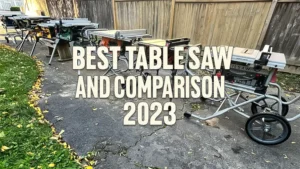
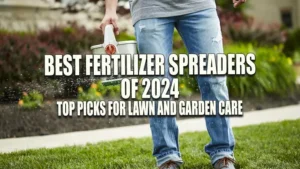
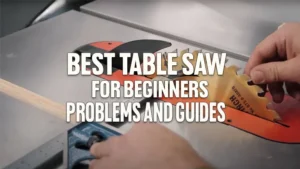
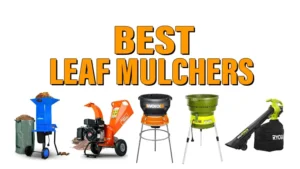


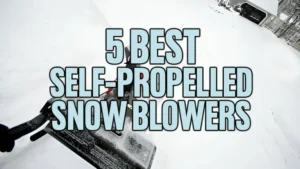
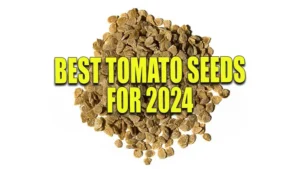
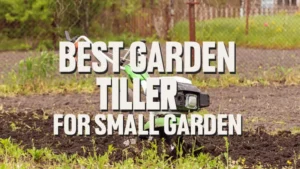
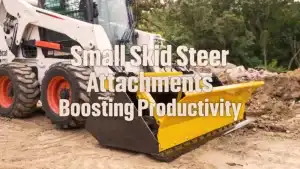

Leave your comment